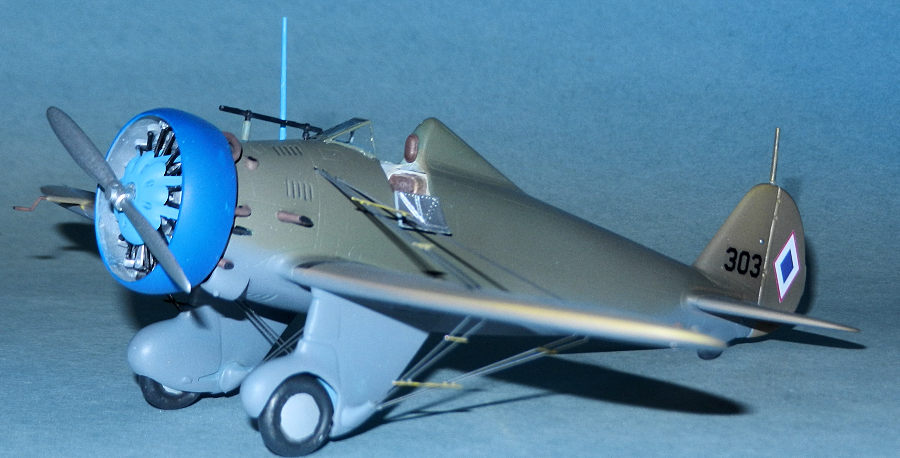
| KIT #: | 1558 |
| PRICE: | CAD$30.00 |
| DECALS: | Two options |
| REVIEWER: | Pablo Calcaterra |
| NOTES: |

| HISTORY |
The first modern fighter of the USAAC the P-26 was quickly left behind by other planes in the fast evolving aviation of the 30s.
With several being transferred to the Philippines and flown by the 3rd Pursuit Sqn. As the inventory of the USAAC was improving with more modern models (P-35s and P-40Bs) the P-26 were sold to the Philippines Army Air Corps and served in their 6th Pursuit Sqn. Numbers vary from 12 to 14 planes. These were inducted into the PAAC on July 26, 1941.
Originally the planes had been painted with blue
fuselages and yellow wings (with engine cowling in different USAAC squadron
colours like red, white or dark blue). When they were taken over by the PAAC the
planes were repainted. Now there’s a big debate about those colours (from two
tone greens, brown and
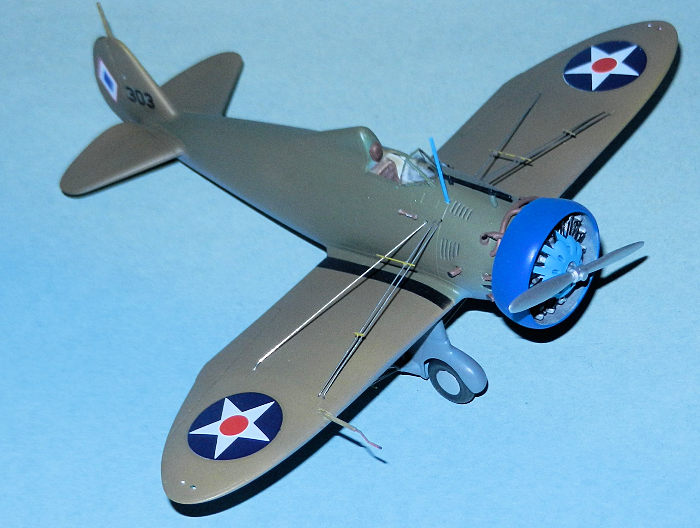 green to a
single green). An excellent
reference is Tony Feredo's where he dispels lots of the myths. It
looks like that from coloured, to primed, to OD with the USAAC bade overpainted
with a darker colour there was a very significant variation in those 12+ planes
(coded 301 onwards).
green to a
single green). An excellent
reference is Tony Feredo's where he dispels lots of the myths. It
looks like that from coloured, to primed, to OD with the USAAC bade overpainted
with a darker colour there was a very significant variation in those 12+ planes
(coded 301 onwards).
The Japanese attack on the islands happened on December 8, 1941. Because of lack of initiative, mistakes and unpreparedness by the end of that day (McArthur’s Pearl Harbor) almost half of the Allied planes had been destroyed.
On Decenmber 10th the P-26s finally saw combat. The 6th Pursuit Squadron was at Nichols Field. At 11:30 am while the unit was having lunch the alarm was sounded. Capt. Villamor, along with Lieutenants Godofredo Juliano, Geronimo Aclan, Alberto Aranzaso, and Jose Gozar climbed in their planes and faced Nell bombers escorted by Zeros. Villamor was first to take off and meet the attackers, only to find himself greatly outclassed by the better Japanese fighters. A Japanese Zero gave chase, and Capt. Villamor maneuvered his aircraft to shake off his opponent. He dove his P-26 and hugged the tree tops of the Marikina Valley and even flew under high tension wires. The Japanese pilot gave up the chase thinking he hit the ground. Capt. Villamor then pulled up only to find himself being pounced by another Japanese Zero. He swung his aircraft on a vertical left bank, putting it on a stall but training his guns towards a face-to-face engagement with the enemy. The Japanese pilot was surprised by the maneuver, but Capt. Villamor was able to fire off first hitting the wings of the Zero and bursting it into flames. This was the first confirmed kill by the PAAC. Though outclassed by the Zeros and struggling to get to the Japanese bombers the guts and skills of the PAAC pilots allowed them to claim 4 kills (1 Nell and 3 Zeros). Two of those kills were attributed to their Sqn Leader Captain Jesus Villamor. The 6 PAAC planes had faced 54 Japanese planes.
On December 12th a force of 27 bombers and 17 fighters targeted Batangas Airfield where now the P-26s were based. The PAAC flight group of 5 P-26s headed by Capt. Villamor scrambled to meet the closer flight of enemy bombers heading south. Lt. Cesar Basa had been sent on a recco mission two hours before and decided to tag to Villamor as his wingman. Diving on the Japanese Villamor and the PAAC flight attacked the lead aircraft of the Japanese Nell bombers and they managed to shoot it down. This was Villamor’s second kill of the war. The Japanese Zeros pursued the defenders, and in the ongoing melee the PAAC relied on cloud cover and outmaneuvered the faster Zeros through tighter turns. Lt. Basa meanwhile kept on Capt. Villamor's tail, but was soon pounced on by a Japanese Zero. Villamor saw an enemy plane shoot down his friend Cesar Basa’s plane. “I heard the scream of bullets, of the Zero’s tracers chewing into the thin metal skin of his P-26,” he wrote. “The last time I saw him he was struggling to free himself from his cockpit.” With his plane damaged the P-26s wings broke off, but Lt. Basa was able to bail out of his P-26. Basa's bullet riddled body was later found, and according to Capt. Villamor's account, the former was shot up by Japanese fighters while parachuting down. Lt. Basa became the first Filipino casualty from aerial combat. Lt. Antonio Mondingo meanwhile was also shot by a Japanese attacker, and was forced to bail out. Upon landing, he was rescued by civilians. Lt. Manuel Conde’s plane was damaged but was able to land his P-26 in Zablan Field. However, his aircraft exploded moments after he exited and took cover from the onslaught of Japanese strafing. At the conclusion, the Japanese lost two bombers, while the PAAC lost 3 aircraft.
The 6th Pursuit Squadron returned to Nichols Airfield on December 13 with 4 remaining P-26s, and on the following day, Lt. Gozar in turn for the last time in the war was able scramble by himself to meet the Japanese raiders. Lt. Gozar was able to survive the encounter against three Japanese Zeros with one unconfirmed kill, and land his heavily damaged fighter.
For this feat he received the DSC. The citation reads:
“The
President of the United States of America, authorized by Act of Congress July 9,
1918, takes pleasure in presenting the Distinguished Service Cross to Captain
(Air Corps) Jesus A. Villamor (ASN: 0-888072), Philippine Army Air Corps, for
extraordinary heroism in connection with military operations against an armed
enemy while serving as Pilot of a P-26 Fighter Airplane in the 6th Pursuit
Squadron, Philippine Army Air Corps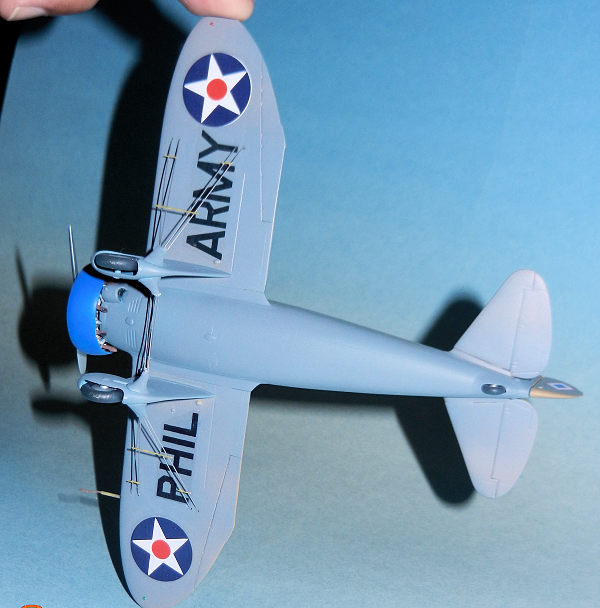 ,
attached to the FAR EAST Air Force, in aerial combat against enemy Japanese
forces on 10 December 1941, during an air mission over Air Batangas, Philippine
Islands. In the face of heavy enemy fire from strong air forces, Captain
Villamor led his flight of three pursuit planes into action against attacking
Japanese planes. By his conspicuous example of courage and leadership at great
personal hazard beyond the call of duty his flight was enabled to rout the
attacking planes, thereby preventing appreciable damage at his station. Captain
Villamor's unquestionable valor in aerial combat is in keeping with the highest
traditions of the military service and reflects great credit upon himself, the
Philippine Army Air Corps, and the United States Army Air Forces”.
,
attached to the FAR EAST Air Force, in aerial combat against enemy Japanese
forces on 10 December 1941, during an air mission over Air Batangas, Philippine
Islands. In the face of heavy enemy fire from strong air forces, Captain
Villamor led his flight of three pursuit planes into action against attacking
Japanese planes. By his conspicuous example of courage and leadership at great
personal hazard beyond the call of duty his flight was enabled to rout the
attacking planes, thereby preventing appreciable damage at his station. Captain
Villamor's unquestionable valor in aerial combat is in keeping with the highest
traditions of the military service and reflects great credit upon himself, the
Philippine Army Air Corps, and the United States Army Air Forces”.
On December 24 the remaining P-26s where burned. In his biography “They never surrendered” Villamor says that they due to the retreat of the Allied armies they had to “Destroy our planes, reduce to ruins my No. 303”. He then added “Still it pained me to have them destroyed, I walked to my 303 for a last farewell. Slowly I moved around the once proud fighter to whose fibre, my body , my mind, had once been welded. Her stubby body was now scarred and pitted. The wire braced wings were no longer smooth. The streamline fairings which housed the wheels were torn. All over her olive drab there were bare metal patches of aluminum. Still she could fly. She could still lift me from the ground. I ran my fingers over the USAAC roundel with the white star and red center on the wing…… I could not destroy the plane, I told a sergeant to do the job…”
After flying incredible missions in biplanes during the last weeks of the war in the island, Villamor was sent to Australia where he participated in the training of P-40s pilots. In 1943 he returned by submarine to the Philippines and acted as guerilla coordinator. He survived the war and become a national hero. Colonel Jesus Villamor Air Base, known simply as Villamor Air Base, is the headquarters of the Philippine Air Force and shares runways with Ninoy Aquino International Airport. It was formerly known as Nichols Field or Nichols Air Base.
| THE KIT |
The Hobbycraft kit has been around since the 90s. It’s quite simple and parts in the box allow you to build an early or late plane (most significant difference is the arrangement of the exhausts).
It’s easy to build, well-engineered. One of the things I liked is that the location for the rigging is already made (very tiny holes). Decals are simple, slightly off register but usable.
| CONSTRUCTION |
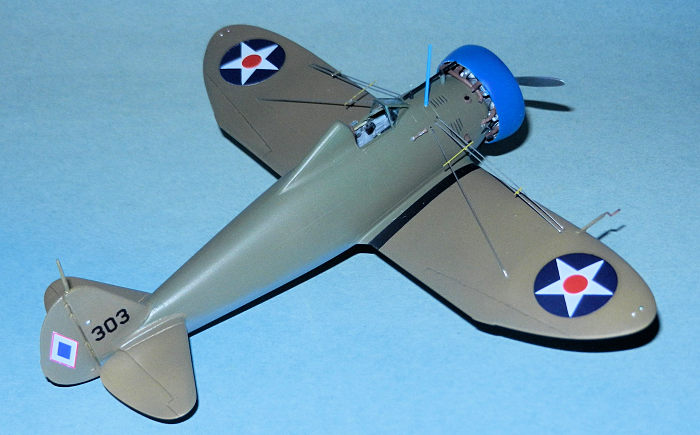 It is very
straightforward. I painted all interior aluminum with instrument panel in black
and details highlighted with drybrushed aluminum. Seat belts were made with
Tamiya tape pained Sand. The cockpit was dirtied with dusted brown pastels due
to the muddy environment.
It is very
straightforward. I painted all interior aluminum with instrument panel in black
and details highlighted with drybrushed aluminum. Seat belts were made with
Tamiya tape pained Sand. The cockpit was dirtied with dusted brown pastels due
to the muddy environment.
Very little putty was required. Only place I can remember is the union of the wheel spats and the wings. Talking about what I removed the external portion of the spat around the wheels to get them eventually exposed. Otherwise a very good fit overall.
The small engine is simple. The two halves of the cowling were put together with the interior painted in aluminum. With this the model was ready for the paint session(s)
| COLORS & MARKINGS |
A coat of light grey Vallejo primer was applied except for the areas where I as going to paint the PAAC diamonds where the primer was white. So far, so good. Disaster struck when I started to apply light coats of Vallejo Yellow. The difference in colour of the primers was very evident. No matter how many coats the primes where showing thru or giving the yellow a clear difference.
Frustrated I put the plane under the tap and removed the yellow…which also removed most if not all of the primers on the wings (not the all grey primed fuselage)! A little bit of sandpaper removed what remained of the primers.
Back to the drawing board…my idea of painting the diamonds gone (now that I have managed to print good decals myself) I gave the plane a new coat of light grey primer. And then again I started with the Yellow (MM 4721 / FS33538) that now delivered an even coat to rudder, tail and wings.
After masking the yellow areas I painted the fuselage, the front cover for
the engine and wing spats in Light Sea Blue (Vallejo 71.089 / FS35260). The
cowling was painted Dark Blue (MM 4660 / FS13471). After unmasking the plane
the undersides including the wheel spats were painted with very light coats
of Neutral Grey (Vallejo 70.992). Undersides were masked and the top portion
of the plane was again lightly sp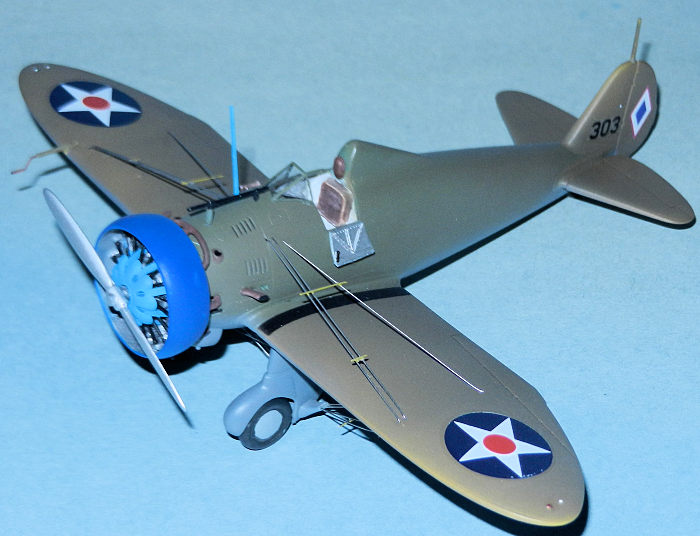 rayed
this time with Olive Drab (MM 4728 / FS34087). The end result was 4
different tones of cammo: NG over yellow, NG over blue, OD over yellow, OD
over blue. I think it is a good mixture of colours that represent the spotty
and uneven look of these planes.
rayed
this time with Olive Drab (MM 4728 / FS34087). The end result was 4
different tones of cammo: NG over yellow, NG over blue, OD over yellow, OD
over blue. I think it is a good mixture of colours that represent the spotty
and uneven look of these planes.
Exhausts were painted in rust with some drops of black in the openings. The engine was painted aluminum with the details highlighted with light washed of black paint. Propeller was painted aluminum. For the first time and after testing on my hack (very old Airfix Spitfire) I gave the model a single (more about that later) coat of Vallejo Gloss Varnish using 20 psi and diluted 10:4:1 Barnish:Vallejo Thinner:Vallejo Flow improver.
The USAAC roundels came from the kit. The PAAC diamonds I printed on white decal paper. On clear paper I printed the “303” flown by Villamor.
The word “Army” comes from the kit but I replaced the “US” with the “PHIL” that I printed on clear decal paper. The walkways on the wing roots came from the kit, and that’s all. Very few decals on these old planes.
A coat of Model Master Acrylic Flat Barnish sealed the decals. Regretfully at this point some silvering was found under parts of Army, Phil and some 303. And it makes sense because the coat of Vallejo Barnish had not delivered a very smooth but slightly pebbly texture. Instructions called for a potential second coat after 24 hs but I ignored this thinking it was shinny enough. Mistake learnt and when a second coat was applied in my next project there was no silvering at all.
With all that out of the way, I attached the exhausts to the engine following the late P-26 configuration (that I found in Scalemates’ HC instructions), added the engine and the cowling. I rigged the plane using 0.010 aluminum wire with the braces made of a slightly thicker gauge painted in the cammo colours.
Headrest was added, windshield glued. Dropped down door on the left side of the plane, wheels, gunsight and antennas plus the pitot were glued in place. Navigation lights were painted with a base of Chrome Silver and a tiny drop of clear green and red from MM (wings) and Future (tail). The last detail was the attachment of the propeller.
| CONCLUSIONS |
A very simple and small kit that captures the lines of the P-26s flown with big cojones by the Filipinos in the dark days of 1941.
Thanks to:
Tony Federo
| REFERENCES |
Wikipedia
2 September 2024 Copyright
ModelingMadness.com. All rights reserved. No reproduction in part or in whole
without express permission. If you would like your product reviewed fairly and fairly quickly, please
contact
the editor or see other details in the
Note to
Contributors.